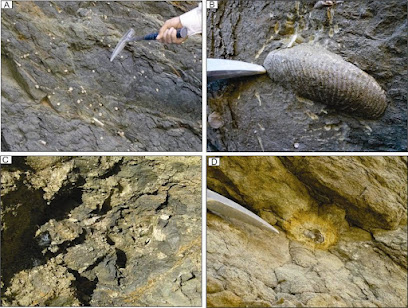Belemnites
(Belemnitida) were squid-like organisms that belonged to the mollusk phylum's
cephalopod class and were thus linked to ancient ammonites as well as modern
squids, octopuses, and nautiluses.
Their
fossils can be found in rocks from the Jurassic and Cretaceous periods, with a
few species surviving until the Tertiary period. The soft sections of the
animal rarely fossilize, leaving us with only the guard and the phragmacone.
Unlike
nautiloids and ammonites, belemnites had a rostrum, which was a very rigid
internal skeleton. Many people are familiar with belemnite rostra, which are cylindrical
and resemble bullets.
Paleontologists have
discovered belemnite fossils that illustrate their interior structure and soft
components in addition to their shells. These fossils reveal a lot about how
these creatures lived. Belemnites possessed huge eyes and used jet propulsion
to swim swiftly. They could certainly shoot clouds of black ink at their
enemies to avoid the attack, just like the octopus.
Figure 1 A piece of the belemnite animal's flesh has been removed to reveal the internal hard parts. Charlotte Miller provided the image.
Anatomy
Belemnites were squid-like creatures with ten arms, each coated with 30-50 curved hooks for catching prey such tiny fish, mollusks, and crustaceans. Belemnites, unlike modern squids, lacked a pair of tentacles. Take a look at this useful guide if you're not sure what the difference between cephalopod arms and tentacles is. Tentacles have suckers only at the end, while arms have suckers all the way down. Belemnites had beaks, ink sacs, and a tail fin, just like other Coleoidea (a superclass of shellless cephalopods that includes octopus, squid, and cuttlefish).
Figure 2 Complete belemnite fossil with the tail fin.
The Rostrum
Despite their similarities, belemnites and modern squids differ in that the latter lacks a rostrum. Belemnite gets its name from the Greek word "belemnon," which meaning "dart." The rostrum supported the remainder of the body and acted as a counterweight. The phragmocone, a conical structure containing chambers that controlled buoyancy and balance, is located near the base of the rostrum.
Figure 3 The rostrum is divided into sections. The phragmocone (FRAGMOCONO) and rostrum cross-sections are shown (SEZIONI DI ROSTRO).
Calcite, a carbonate mineral, makes up the rostrum. A cross-section of the rostrum reveals concentric rings, similar to those found inside a tree, with each ring representing a few months. Because calcite is so robust, the rostrum is often the sole part of the belemnite that has been preserved. Hundreds of rostra can be found on some rock outcrops. These are known as belemnite battlefields, and they're supposed to reflect widespread death following mating, as seen in modern squid. Because belemnites were frequently devoured by marine reptiles and huge fish, rostra can be found fossilized within other creatures.
Figure 4 Belemnite rostra (black items) in the gut of Hybodus sp.
The Guard
Because the belemnite guard is bullet-shaped, these fossils were once referred to as "bullet stones." This section of the organism was made of calcite and tapered to a point at the extremities, farthest from its head. The guard was depressed by a conical hollow called the alveolus at the end closest to the head. The base of the phragmacone was discovered within this. The guard is supposed to have served as a counterbalance to the phragmacone. Calcite is almost always found in guard fossils.
The Phragmacone
The phragmacone reached out from behind the guard. It was a conical structure with simple concave sutures that served to control the animal's buoyancy. Due of its more brittle nature, this component of the belemnite is less commonly found as a fossil than the guard. When discovered, it may be preserved in a number of rock or mineral types, such as mudstone, pyrite, or calcite, and may be inflated or crushed flat, just as it was in life. The phragmacone and guard fossils can sometimes be found remaining linked to one another. The pro-ostracum was a thin, paper-like structure that stretched from the wide end of the phragmacone. It is extremely rare to see this fossilized.
A geologist's best friend
Because belemnite rostra are so common in the fossil record, geologists study them to learn about former environmental conditions. In rostra, carbon isotope ratios are linked to levels of primary productivity (photosynthesis), whereas oxygen isotope ratios are utilized to calculate ocean temperatures. The palaeocurrent during sediment deposition can be determined from the alignment of rostra in a rock outcrop. Some rock units, such as the 182.7-190.8 million-year-old Belemnite Marls in Charmouth, England, are called after their high proportion of belemnites.
Stratigraphy
Belemnites fossils are found in the stratigraphic sequence of the Upper Jurassic to Lower Cretaceous in the Surghar ranges, moreover, belemnites are also reported in beleminitic shales of sembar formation and also in Goru Formation. They are also found in different stratigraphic sequences of the Kohat sub-basin.
Figure 5 Details of the Chichali Formation's middle and upper members. A, A glauconitic ridge forming sandstone rich in belemnites in the middle member; B, Ammonite in the middle member sandstone; C, Close up of black shale in the upper member's basal portion; D, Weathered phosphate nodules in the upper member.








Comments
Post a Comment